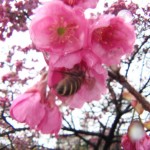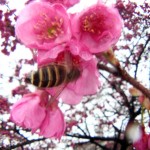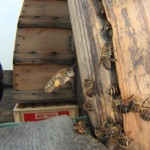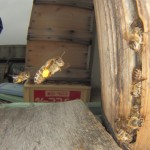These are photographs taken by Associate Professor of Entomology, Satoshi Kamitani, with a Canon DSLR camera equipped with a special fisheye lens setup on March 5, 6, and 7, 2012.
The pictures of are of the native Japanese honey bee, Apis cerana japonica, which I am keeping in a pair of hives on the roof of the main building of the School of Agriculture at Kyushu University, Hakozaki Campus, Fukuoka, Japan.
Japanese honey bees will fly and work at lower temperatures than European honey bees will. They will also fly under somewhat more adverse weather conditions too, such as rain. European honey bees usually will not fly until the outdoor temperature is above 50 degrees Farenheit (10 degrees Centigrade), while Japanese honeybees will fly when the temperatures are in the 40′s F.
The weather is just starting to warm up here, and the first of the cherry trees are blossoming now. The flowers pictured are of a cherry tree that is native to Taiwan and blooms earlier than traditional Japanese flowering cherry blossoms. Plums are blossoming now too since they are earlier than cherry trees.
The bees are bringing in loads of pollen that is used to feed the bee larvae (baby bees), along with nectar or diluted honey. Honey diluted with water is used early in the spring before the nectar producing flowers become predominant. When the nectar flow begins, then the bees use nectar and pollen to feed the brood rather than honey. Of course honey stores are used by the bees to overwinter. It is the fuel they use to keep the center of the hive (where the queen stays) warm in the winter when it is cold outside. It is said that honey bees will not die from the cold, but if they run out of honey they will starve and then die. They generate heat using the flight muscles in their thorax, using honey as fuel.
It looks like it is going to be a good year for me and the bees this year. I have been able to figure out which local city government offices to call to find out when people call about bee swarms and bee problems, and the people who work there have agreed to call our entomology department and let us know when they receive calls about bees this spring. They said that they will stop calling us after we get all the bees we want. I am optimistic that I will be able to establish a number of new hives this year. If things go well, I may even get enough calls to let me “share the wealth” with other people locally who would like to keep bees too. I will let you know what happens as the season progresses.







That sounds a lot like the “backwards beekeeping movement” in some parts of the US http://www.backwardsbeekeepers.com/ very cool